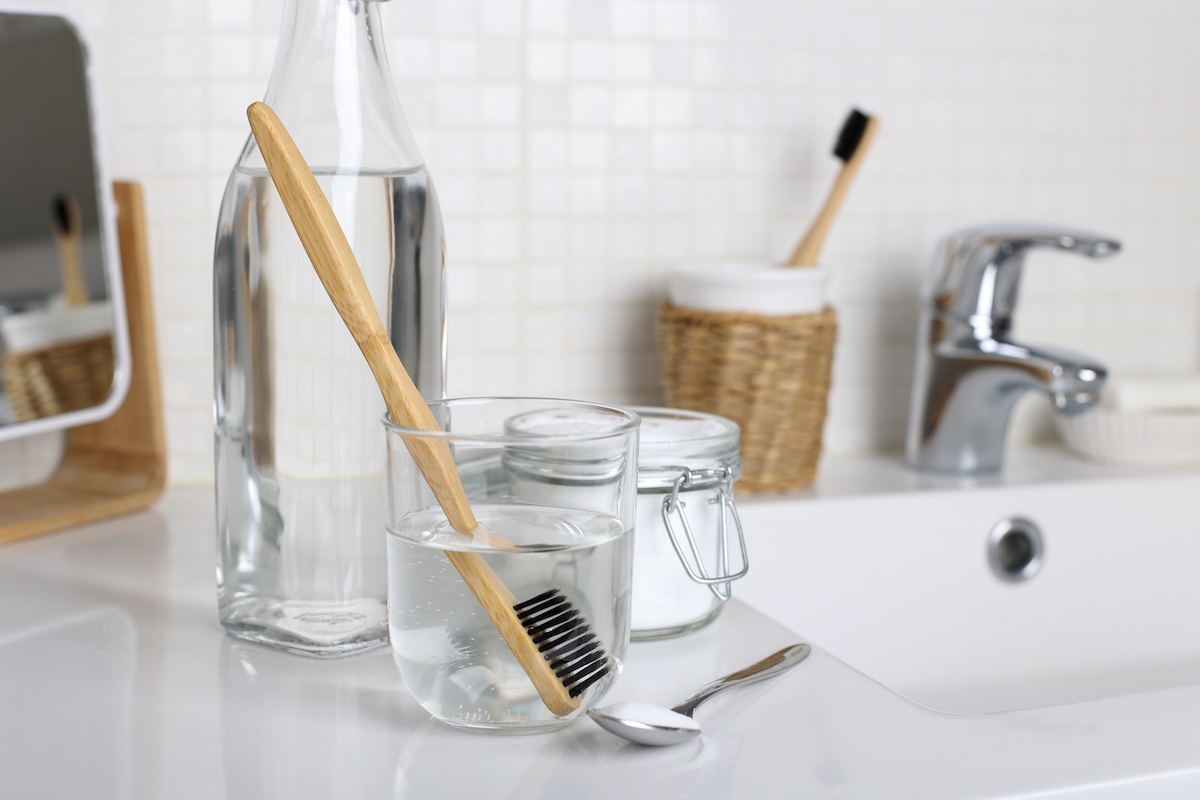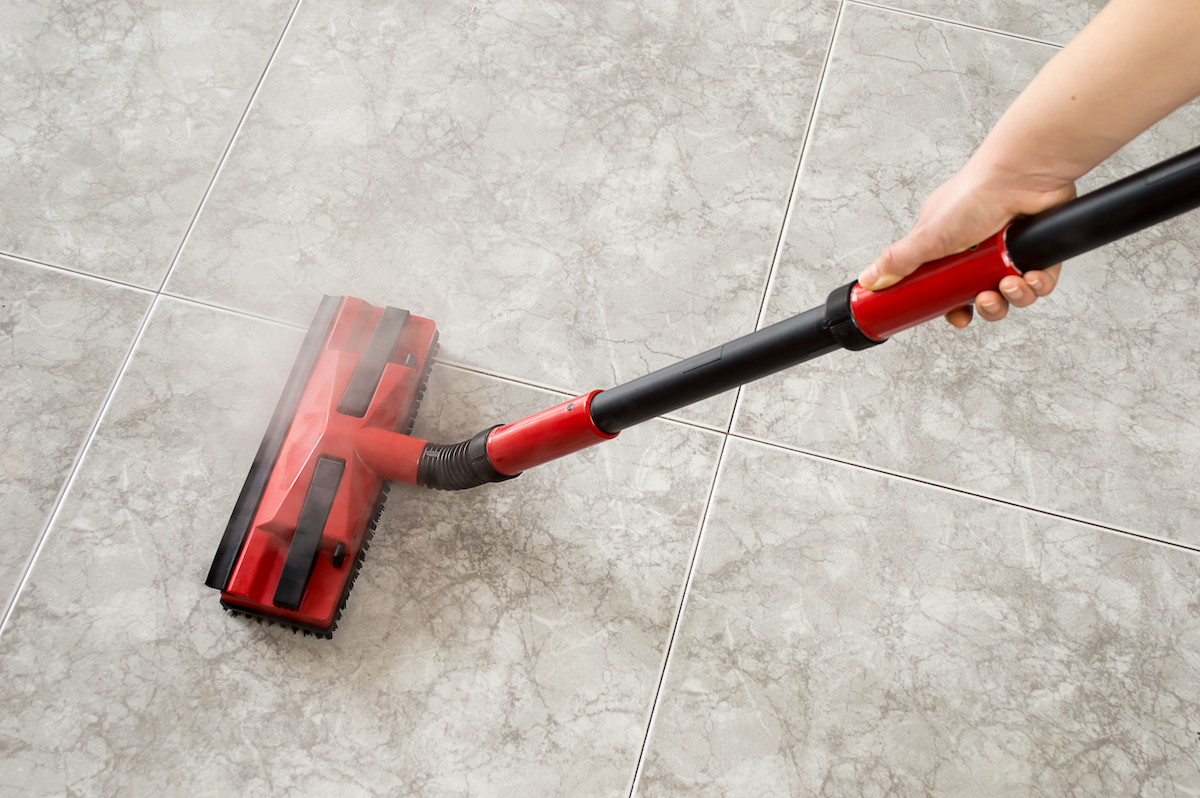The Super Secret Methods Experts Use to Clean Grout

Tile remains a popular choice for floors, backsplashes, showers and more throughout the home. Keeping this tile looking like new is quite easy as long as you clean it regularly.
However, you may notice that the grout between your tiles looks a bit dull or shows mildew spots. This may be because you don’t necessarily clean it with the same attention you would when cleaning tile. But with the right tools, you could have your tile grout looking as good as your tile.

Know the types of grout
Although they may look alike, tile grout comes in many different forms, and it’s important to know what type of grout you have in order to properly clean it.
Sanded grout
Made with cement, sanded grout has a gritty feel often used with tiled floors in high traffic areas because it is stronger and less likely to crack. It’s usually in joints over 1/8 inch wide.
Grout without sand
Also a cement grout, unsanded grout doesn’t have the gritty feel due to the lack of sand. It is used with polished stone tiles, especially with vertical surfaces like backsplashes and shower walls. It is typically used in joints less than 1/8 inch wide.
Epoxy grout
Less porous than grout with and without sand, epoxy grout contains epoxy resin, pigments, hardener and silica. It is more durable than cement-based grouts, making it less susceptible to cracking and shrinkage.
Sealed or unsealed grout
Regardless of the type of tile grout you have, it’s important to know whether or not your grout contains a sealer. The grout sealer will help protect the grout from mold and mildew, protect it from spills and stains, and extend the life of the grout. Knowing whether or not your grout contains sealer will play a role in what cleaners you can use to avoid damaging the sealer.

Cleaning products needed to clean dirty grout
To effectively clean your grout, make sure you have your cleaning supplies handy. These include:
- Latex or cleaning gloves
- Sponges
- Spray
- Nylon Bristle Brush
- old toothbrushes
- Towel or cleaning rags
- Baking soda
- Hydrogen peroxide
- White vinegar
- Dishwasher soap
- Grout Cleaner
- Steam broom
6 of the best ways to clean grout
In these grout cleaning tips, you’ll follow a similar set of steps that may vary depending on the cleaner used and how dirty the grout is. Essentially, you’ll remove surface dirt, apply cleaner, let the cleaner do its job, scrub, rinse and dry.
To ensure you don’t scratch your tile or damage the grout, start with the least corrosive cleaner for removing grout stains and move on to the next only if necessary. When you’re ready, try one of these ways to clean grout to get yours looking like new.
1. Just start with lukewarm water and a stiff bristle nylon brush
Often the simplest cleaning solution is the best. Spray the grout with warm water and brush in circles with the nylon brush or an old toothbrush. Never use a wire brush or steel wool on your grout, as this could scratch the tile or break the grout.
When cleaning grout, do not apply too much water. Use only enough to soften mold and grime. As the mildew and dirt dissolves, wipe them away with a cleaning cloth. Continue until the grout is clean.
2. For sealed grout, apply a mixture of warm water and vinegar
Vinegar is a popular household cleaner, and using it on sealed grout (only!) is effective. To make your own grout cleaning solution, mix equal parts warm water and white vinegar in your spray bottle and apply it to the grout lines. Let the vinegar solution sit for up to five minutes and scrub with a small brush.
If necessary, spray clear water to remove dirt. Wipe with a damp cloth, making sure to remove any excess vinegar solution and moisture.

3. Add baking soda for an extra punch
For sealed grout (only!), adding baking soda might be the extra ingredient needed to remove dirt and grime thanks to its mildly abrasive characteristics. Start by mixing water with baking soda to create a paste.
Apply the paste to the grout lines and spray the vinegar/water mixture. The mixture will start to foam, which is normal. Once it stops foaming, scrub with a toothbrush or scrub brush and rinse with clean water. Wipe.
4. For tough stains, try hydrogen peroxide, baking soda, and dish soap
When cleaning grout, very stubborn stains may require more cleaning power. Mix ¼ cup hydrogen peroxide, ½ cup baking soda and 1 teaspoon dish soap until well blended.
Apply this solution to the grout lines and allow the mixture to sit for five to 10 minutes. Scrub with a toothbrush or nylon brush to clean dirt and rinse with water. For stubborn stains, reapply the mixture and try scrubbing again. Use a cleaning cloth to wipe away the dirt and dry the grout.
5. Use grout cleaner on grout lines
You will find many grout cleaners at your local big box store, home centers and other retailers. When using any of these products, it is imperative that you choose one for your type of grout, including whether it is sealed or unsealed. Equally important, read all instructions before using, especially the safety precautions.
Depending on the grout cleaner you choose, you’ll likely apply it to the grout lines and wipe it off or apply it and scrub until it’s clean. It’s a good idea to test the product in an inconspicuous area, such as behind the toilet or in your pantry.

6. Try a Steam Cleaner to Clean Grout
If you have a steam mop, this might be the best method for cleaning dirty grout. However, it is important to only use plain water in your steam mop. Also, don’t use a brush unless it’s a nylon brush. Prepare your sponge or cleaning cloth to wipe away the dirt.
Also remember to monitor the amount of water and moisture that accumulates when using the steam mop. Porous, unsealed tiles could absorb this excess, leading to mold and mildew growth in the future. Use a clean, dry cloth or towel to dry the surface of the grout when you’re done.
Do not use these cleaners on your grout
While you might consider using bleach or oxygen bleach to clean grout from your tile or kitchen tile, don’t. While these mixtures can clean stained grout, they could bleach the color of your grout. This may look good for white grout, but it won’t work well for colored grout.
Additionally, the bleach could break down the grout sealer, making it more susceptible to mold and mildew. If you have a stubborn stain, you can apply a few drops of bleach or oxygen bleach to the surface of the grout and scrub it with a toothbrush. Be sure to avoid tiles so you don’t leave bleach stains behind.
Also, remember that vinegar should only be used on sealed grout. Also, avoid the electric toothbrush, which could apply too much pressure and break up the grout.

Be careful when cleaning grout
There are some safety precautions you should take when cleaning grout in small, enclosed areas, such as tile on bathroom floors or inside showers.
For example, when using bleach, make sure the area is well ventilated. Also, never mix baking soda and vinegar in a closed container as it may explode. And never mix vinegar with bleach.
Always have the phone number National Capital Poison Control Center close at hand if you breathe harmful fumes.
What is the best homemade tile grout cleaner?
As noted in #4 above, a mixture of baking soda, hydrogen peroxide, and dish soap is one of the best homemade tile grout cleaners. Add a little elbow grease and your grout will be looking great in no time.
What do professionals clean grouts with?
Many professionals prefer the mixture noted in #2 above, a mixture of vinegar and water.
Keep your grout clean
Now that your grout is clean, keep it that way by washing and rinsing it weekly. Not only will this keep your grout looking great, but you’ll likely get away with the simple technique of washing it off with water. This will keep your grout looking good and save you money on cleaning supplies.




